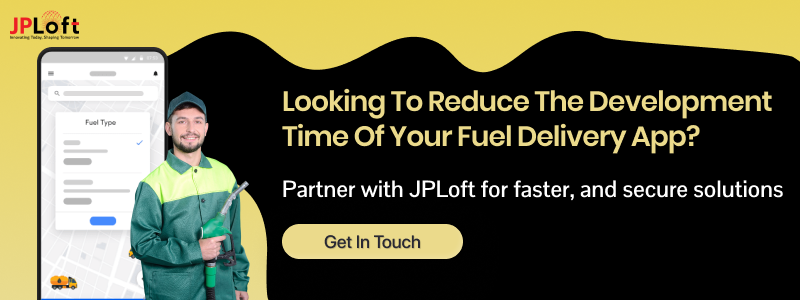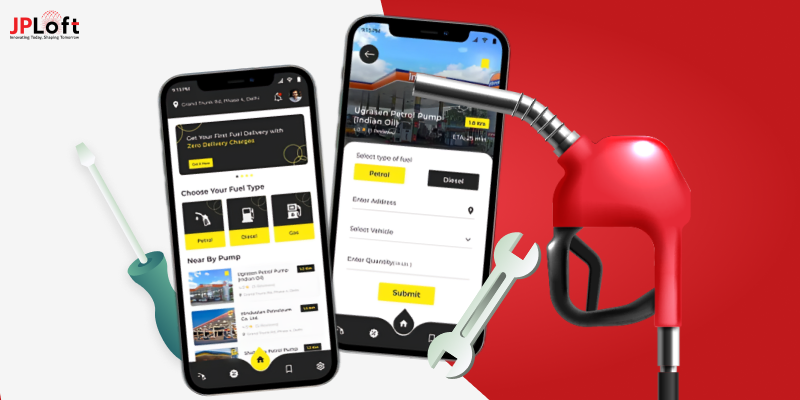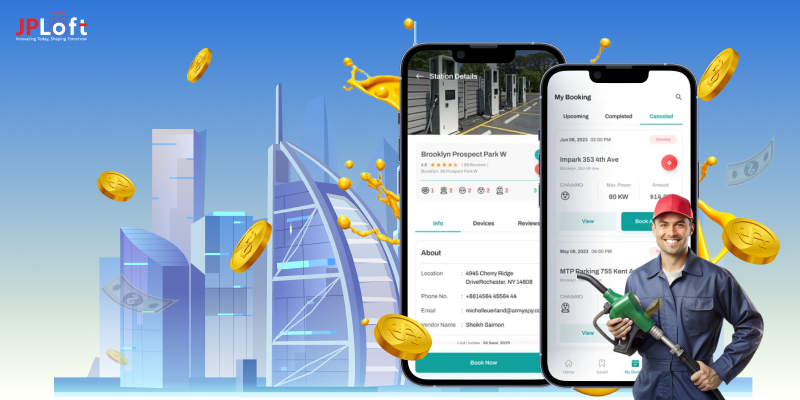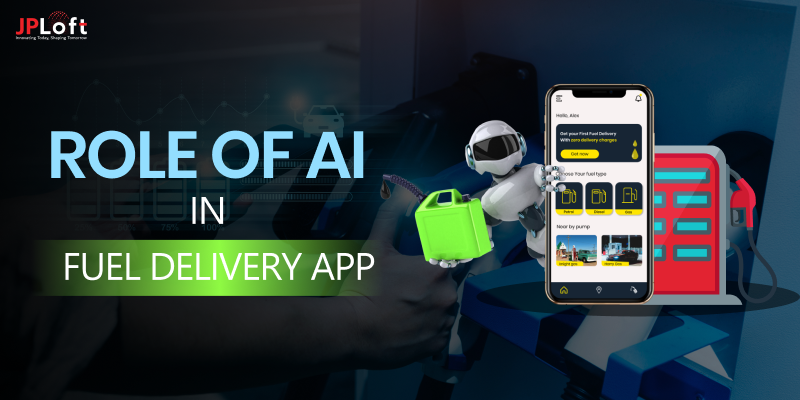In today's competitive world, knowing the fuel delivery app development time is key to planning and executing your project efficiently.
This blog offers useful tips to shorten the time to develop a fuel delivery app without sacrificing quality or functionality. Typically, a basic fuel delivery app might take around 3 to 5 months to develop, while a more advanced version could require 8 to 12 months.
We will examine strategies like prioritizing key features, adopting Agile methods, and leveraging cross-platform tools to streamline the process.
If you are curious about the estimated time to develop a fuel delivery app or looking for ways to reduce the time to build a fuel delivery app, this guide provides simple, useful insights to help you achieve faster results.
Overview of the Fuel Delivery App Market
The fuel delivery app market has experienced significant growth in recent years, driven by the increasing demand for convenience and efficiency in refueling services.
Mobile fuel delivery systems enable consumers and businesses to receive fuel directly at their location, eliminating the need to visit traditional gas stations.
Key Market Statistics:
-
Market Size and Growth: In 2024, the global mobile fuel delivery system market was valued at approximately $5.06 billion and is projected to reach $8.75 billion by 2032, growing at a CAGR of about 7.1% during the forecast period.
-
Projected Market Value: Another report forecasts that the mobile fuel delivery market will expand from an estimated USD 5.4 billion in 2024 to USD 8.9 billion by the end of 2031, registering a CAGR of 7.3% during the forecast period (2024-2031).
-
Demand Drivers: The market's growth is fueled by the rising demand for convenience, advancements in fleet management technologies, and the increasing popularity of on-demand services.
-
Technological Integration: Service providers are increasingly adopting advanced technologies such as the Internet of Things (IoT) and cloud computing to enhance operational efficiency and customer experience.
-
Regional Insights: North America remains a key market, driven by technological adoption and a declining number of gas stations, positioning the region for substantial growth in the mobile fuel delivery sector.
The convenience culture, coupled with technological advances, has positioned mobile fuel delivery services as a transformative answer in the energy and transportation sectors.
As the market continues to change, companies and customers alike are increasingly embracing these services for their efficiency and ease of use.
Let’s move onto the next section to get the idea about how much it takes to develop a fuel delivery app.
Average Time to Develop a Fuel Delivery App
The estimated time to develop a fuel delivery app ranges between 3-12 months, however it relies strongly on the complexity of features, design, third-party integrations, and platform (Android, iOS, or both).
In general, the fuel delivery app development timeline is split into three levels: Basic, Mid-Level, and Advanced. Each level changes in terms of utility and user experience, which directly impacts the overall development hours.
Here is a detailed breakdown:
|
App Type |
Estimated Development Time |
Description |
|
Basic Version |
3 - 5 Months |
A simple fuel delivery app with essential features. This is ideal for startups that want to quickly enter the market with limited but functional features. The fuel delivery app development hours for this version are usually around 3-5 months. |
|
Mid-Level Version |
5 - 8 Months |
This version includes all basic features along with additional functionalities. The time to build a fuel delivery app at this stage may require 5-8 months, depending on customization and third-party integrations. |
|
Advanced Version |
8 - 12+ Months |
The advanced version is a fully-featured and scalable solution. The time to create a fuel delivery app with this level of sophistication often takes 8 months, depending on the project scope and technology stack. |
The fuel delivery app development time can vary based on several factors, such as design complexity, third-party APIs, backend development, testing cycles, and post-launch support.
If you are wondering how long does it take to develop a fuel delivery app for your business, it is advisable to consult the best mobile development company that can give you a tailored timeline based on your specific needs.
Factors Affecting the Estimated Time to Develop a Fuel Delivery App
When predicting the fuel delivery app development time, it's important to keep in mind that a lot of things can have a direct impact on the total amount of time needed.
Every choice affects how quickly or slowly the project goes forward, from how complicated the app is to which technologies are used.
1. Functions and Features
The timeline will depend a lot on how many and what kinds of fuel delivery app features you want.
Basic apps with limited features like registration, buying, and payment take less time, whereas apps with real-time tracking, route optimization, reward programs, and AI-based suggestions will require extra weeks or even months.
2. The Difficulty of UI/UX design
The look of an app is only one aspect of design; the user experience must also be considered. Simple and clean fuel app designs take less time, but if you want dynamic UI, unique animations, and advanced user paths, expect the time to build a fuel delivery app to extend greatly.
3. Choose a Platform (iOS, Android, or Both)
It is faster to build the app for just one device, like Android or iOS, rather than for both. Using Flutter or React Native to make a cross-platform app might save you time, but it depends on how fast you need the app to be.
4. Third-Party Integrations
Integrating payment platforms, real-time tracking APIs, fuel store management, GPS, Google Maps, or fleet management systems will increase the fuel delivery app development hours. Each API connection brings its own set of technical hurdles, testing, and optimization time.
5. Backend & Admin Panel Complexity
A strong base is the core of any fuel delivery app. Advanced analytics, driver management, transaction records, and admin screens will stretch the time to create a fuel delivery app compared to a simple server.
6. Security Features
Fuel delivery apps deal with payment information, location data, and customer details. Implementing advanced security protocols, encryption, and GDPR or PCI DSS compliance will lengthen the schedule but is important.
7. Testing & QA
Testing is an important step. The more features you have, the more time is needed for quality testing, bug fixing, and speed improvement.
In short, there is no one-size-fits-all answer to how long it takes to develop a fuel delivery app. The timeline will rest totally on your app's goals, complexity, and market expectations.
Fuel Delivery App Development Stages & Timeline
Developing a fuel delivery app is a step-by-step process, where each stage directly affects the overall fuel delivery app development timeline.
Below is a detailed breakdown of the key stages involved:
|
Development Stage |
Description |
Estimated Time |
|
Research & Requirement Gathering |
Analyze the market, gather project requirements, create app structure, feature list, and user flow. |
2–3 Weeks |
|
UI/UX Design |
Create wireframes, prototypes, and final app designs focusing on user experience and ease of use. |
3–4 Weeks |
|
App Development (Frontend + Backend) |
Develop core functionalities, APIs, admin panel, customer & driver panels, and database. |
8–14 Weeks |
|
Third-Party Integrations |
Integrate payment gateways, GPS tracking, notifications, and other essential tools. |
2–3 Weeks |
|
Testing & Quality Assurance |
Conduct performance testing, fix bugs, and ensure the app is secure and ready for launch. |
3–4 Weeks |
|
Deployment & Launch |
Upload the app to App Store & Play Store, and handle app store compliance and listings. |
1 Week |
► Research & Requirement Gathering (2–3 weeks)
This is the basis of the entire project. In this stage, business owners, developers, and researchers sit together to describe the project scope.
They identify the target group, key competitors, market trends, must-have features, and cash. Wireframes, initial ideas, and processes are also covered.
Proper study helps reduce costly mistakes later and sets realistic expectations regarding the estimated time to develop a fuel delivery app.
► UI/UX Design (3–4 weeks)
UI/UX design is all about making an attractive and user-friendly system.
The design should provide easy access and smooth exchanges for both customers and delivery drivers.
In this stage, designers start wireframing, prototyping, and finishing visual screens. A well-planned design part promises faster development later. Complex designs will stretch the fuel delivery app development hours, so balancing value and simplicity is suggested.
► App Development (Frontend + Backend) (8–14 weeks)
This is the longest and most technical part where the real app is written.
The frontend involves building user interfaces, while the server handles data processing, user management, order management, payment processing, and more. Both iOS and Android versions (or cross-platform) are created here. Depending on your chosen features, the time to build a fuel delivery app can vary greatly.
► Third-Party Integrations (2–3 weeks)
Fuel delivery apps require multiple connections such as GPS tracking, Google Maps, payment gateways (Stripe, PayPal, etc.), SMS, email alerts, and fleet management systems.
These connections can sometimes be difficult due to compatibility or security reasons, slightly increasing the fuel delivery app development time.
► Testing & Quality Assurance (3–4 weeks)
Before starting, the app gets intensive testing, including speed testing, user testing, bug fixing, and security checks.
App testing guarantees that the app runs easily, without crashes, security loopholes, or functional mistakes. A detailed fuel delivery app maintenance checklist is often made at this stage to spot future app maintenance services.
► Deployment & Launch (1 week)
After successful testing, the app is released on Play Store, Apple App Store, or both.
The launch process includes setting up app store listings, metadata, privacy rules, and beginning marketing materials. After the launch, you can expect to gather customer comments and begin post-launch help.
Tips to Reduce Fuel Delivery App Development Time
By following these strategies, you can effectively shorten the fuel delivery app development timeline and build a high-quality, efficient app in less time:
1. Define Clear Requirements & Prioritize Core Features
Clearly outline your app’s requirements before starting the project.
Focus on building a Minimum Viable Product (MVP) with essential features like user registration, fuel ordering, GPS tracking, and secure payment gateways. This helps reduce the overall fuel delivery app development timeline by streamlining the initial build.
2. Adopt Agile Methodology
Break down the project into smaller sprints using Agile practices.
This approach enables continuous feedback, early bug detection, and quick adjustments. By working in iterations, you can efficiently manage tasks and reduce the time to build a fuel delivery app.
3. Choose Cross-Platform Development
Consider using cross-platform frameworks such as Flutter or React Native.
Developing one codebase for both Android and iOS reduces fuel delivery development cost and time, accelerating the process compared to building separate native apps.
4. Leverage Ready-Made APIs and SDKs
Utilize pre-built solutions for mapping, notifications, and payment integrations.
Using trusted third-party APIs (like Google Maps for real-time tracking or Stripe for secure payments) can significantly cut down development hours, optimizing the estimated time to develop a fuel delivery app.
5. Focus on Continuous Testing and Quality Assurance
Implement regular app testing at every stage of development.
This proactive approach helps identify and resolve issues early, minimizing delays and ensuring that the app performs well upon launch.
6. Partner with Experienced Development Teams
Collaborate with professionals who specialize in developing mobile apps.
Their expertise can streamline the process, ensuring adherence to best practices for fuel delivery app performance optimization and reducing overall development time.
Accelerate Your Fuel Delivery App Development with JPLoft
Looking to reduce the time it takes to build your fuel delivery app without losing quality? JPLoft can help you achieve better results with our proven methods and expert team.
We specialize in streamlining the development process through Agile methods, cross-platform tools, and leveraging pre-built APIs.
Our knowledge in optimizing the timeline helps you to market your product more efficiently. Partner with us to ensure your app is sturdy, safe, and user-friendly while meeting market demands.
As a trusted fuel delivery app development company, we are committed to helping you stay ahead in the competitive landscape. Contact JPLoft today for a free meeting and let’s fast-track your project to success!
Conclusion
Reducing the overall fuel delivery app development time is important for quickly joining the market and finding success.
By prioritizing key features, adopting Agile methods, choosing cross-platform frameworks, and leveraging ready-made APIs, you can greatly shorten the time to develop a fuel delivery app without compromising on quality.
Regular testing and working with experienced developers further ensure that your app is robust, safe, and user-friendly. Following these best practices not only helps you meet project goals but also keeps development costs in check.
In short, with careful planning and smart strategies, you can optimize the estimated time to develop a fuel delivery app and offer a high-performance product that meets customer standards. Embrace these tips to speed up your development process and stay ahead in the competitive market.
FAQs
The estimated time to develop a fuel delivery app can vary based on complexity. A basic app may take around 3 to 5 months, while a mid-level or advanced version can take 8 to 12+ months.
Adopting Agile methodologies, building a Minimum Viable Product (MVP) first, using cross-platform frameworks, and leveraging pre-built APIs are effective ways to reduce development time.
Developing a native app for both platforms typically requires more time since separate code bases are needed, while cross-platform development can reduce the overall timeline.
Yes, by prioritizing core features, continuous testing, and following best practices for fuel delivery app development, you can maintain quality while reducing the overall development time.
A shorter development timeline may help reduce initial costs, but long-term maintenance depends on how well the app is built and how regularly it is updated for performance optimization and security.













Share this blog